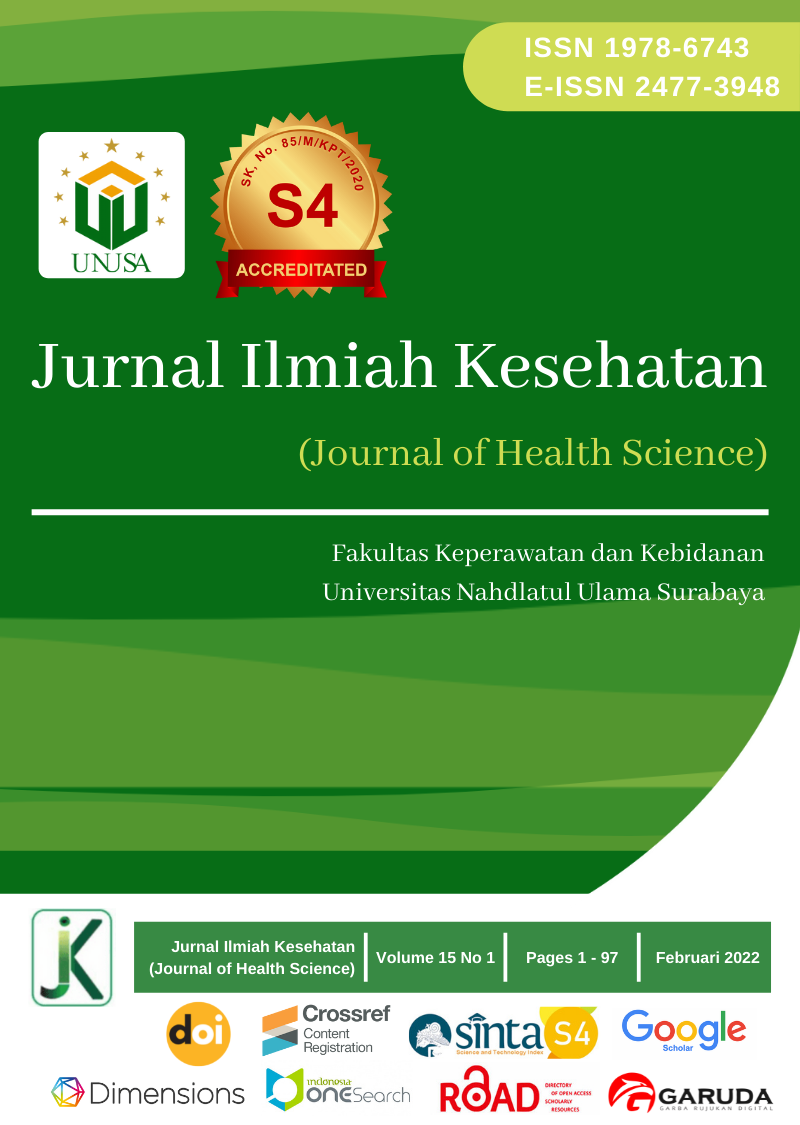Effect of Ergonomic Gymnastics on Systolic Blood Pressure Among Individuals with Hypertension in Kaliasin Family Welfare Development
Main Article Content
Abstract
One of the things that can affect blood pressure is a lack of physical activity. Ergonomic
gymnastics is an exercise that easy to learn and understand. This paper analyzes the
effect of ergonomic exercise on systolic blood pressure among individuals with
hypertension in the Kaliasin family welfare empowerment. This research was a pre-
experimental study with a One-group pre-posttest design. The sampling technique
utilized non-probability sampling with the purposive sampling technique. In addition,
the population was 20 individuals with hypertension in Kaliasin family welfare
empowerment. Fifteen people met the inclusion criteria – 45-55 years old and had stage
I hypertension with 140-159 mmHg systolic. The independent variable was ergonomic
gymnastics, while the dependent variable was systolic blood pressure. Ergonomic
gymnastics were performed six times for two weeks with 25-30 minutes in each
meeting. In addition, the instruments were ergonomic gymnastics manuals with an
observation sheet and a sphygmomanometer. Data analysis utilized the Wilcoxon
signed-rank test with a significance level of 0.05. The results showed that most
respondents had 155-159 mmHg in systolic blood pressure (40%) before the ergonomic
gymnastic. Meanwhile, after the intervention, they had 145-149 mmHg (33.3%) and
150-154 mmHg (33.3%). In addition, the Wilcoxon signed-rank test obtains ρ=0.001
(α≤ 0.05). Thus, there was a difference in systolic blood pressure before and after
ergonomic gymnastics. Ergonomic gymnastics can decrease systolic blood pressure.
Individuals with stage I hypertension should perform ergonomic gymnastics routinely to
avoid the complication of hypertension.
Downloads
Article Details
Copyright (c) 2022 Diyan Mutyah, Hidayatus Sya’diyah, Sukma Ayu Candra Kirana

This work is licensed under a Creative Commons Attribution-ShareAlike 4.0 International License.
References
Bistara, D. N. and Kartini, Y. (2018) ‘Hubungan kebiasaan mengkonsumsi kopi dengan tekanan darah
pada dewasa muda’, Jurnal Kesehatan Vokasional (JKESVO), 3(1), pp. 23–28.
Dinkes (2015) Profil Kesehatan Tahun 2015 Pemerintah Kota Surabaya. Surabaya: Dinas Kesehatan
Kota Surabaya.
Doufesh, H. et al. (2013) ‘Assessment of heart rates and blood pressure in different Salat positions’,
Journal of Physical Therapy Science, 25(2), pp. 211–214. doi: 10.1589/jpts.25.211.
Effendi, Budhi Setianto, Agus Aan Adriansyah, Akas Yekti Pulih Asih, D. N. B. (2021) ‘Dietary Habits
DIYAN MUTYAH / JURNAL OF HEALTH SCIENCE – VOLUME 15 NOMOR 01 (2022) E-ISSN: 2477-3948
https://doi.org/10.33086/jhs.v15.i1.2177 Diyan Mutyah - Effect of Ergonomic Gymnastics on Systolic Blood Pressure Among
Individuals with Hypertension in Kaliasin Family Welfare Development
and Physical Activity Affect Random Blood Sugar Levels in Outpatients’, Journal of Health Sciences,
(03), pp. 202–208. doi: https://doi.org/10.33086/jhs.v14i03.2070.
Fahmi, G. Z. and Widiyatmoko, A. (2013) ‘Pengaruh Senam Ergonomis pada Penderita DM Tipe 2
terhadap Kadar Glukosa Darah Puasa dan Kadar Glukosa 2 Jam Postprandial The Influence of Ergonomic
Gymnastics in the DM Type 2 Patients to the Fasting Blood Glucose Level and the 2 Hours Postprandial
Gluco’, Mutiara Medika, 13(2), pp. 132–136.
Fitriani, N. and Nilamsari, N. (2017) ‘Faktor-faktor yang berhubungan dengan tekanan darah pada
pekerja shift dan pekerja non-shift di PT.X Gresik’, Journal of Industrial Hygiene and Occupational
Health, 2(1), pp. 57–75.
Hamidi, M. (2014) Hubungan Pola Makan dengan Kejadian Penyakit Hipertensi di Puskesmas KUOK.
STIKES Tuanku Tambusai Riau.
Kemenkes (2017) Profil Kesehatan Provinsi Jawa Timur 2016. Jakarta: Kementrian Kesehatan.
Mutaqin, A. (2015) Asuhan Keperawatan Klien dengan Gangguan Sistem Kardiovaskuler. Jakarta:
Salemba Medika.
Nunik, F., Hakimi, M. and Huriah, T. (2015) ‘Pengaruh Peregangan Senam Ergonomis terhadap Skor
Nyeri Musculoskeletal Disorders (MSDs) pada Pekerja Pembuat Kaleng Alumunium’, Indonesian
Journal of Nursing Practices, 2(1), pp. 19–26.
Nuraini, B. (2015) ‘Risk Factor Of Hypertension’, Journal Majority, pp. 10–19.
Palmer (2007) Simple Guide. Jakarta: Erlangga.
Prasetyo, Y. (2015) ‘Kesadaran Masyarakat Berolahraga Untuk Peningkatan Kesehatan Dan
Pembangunan Nasional’, Medikora, 11(2), pp. 219–228. doi: 10.21831/medikora.v11i2.2819.
Riskesdas (2013) Informasi Pusat Data dan Informasi kementrian Kesehatan RI Situasi Lanjut Usia
(Lansia) di Indonesia. Jakarta: Kemenkes RI.
Safitri, M., Safri and Jumaini (2015) ‘Efektifitas Senam Jantung Sehat dan Senam Ergonomik Kombinasi
Relaksasi Nafas Dalam Terhadap Tekanan Darah Pada Penderita Hipertensi Primer’, Jurnal Online
Mahasiswa Program Studi Ilmu Keperawatan Universitas Riau, 2(2), pp. 1250–1257.
Sase, A. (2013) ‘Hubungan Durasi Aktivitas Fisik dan Asupan Nutrium Dengan Tekanan Darah Pada
Wanita Monopouse’, Journal of Nutrition College, pp. 287–293.
Syahrani (2017) Pengaruh Senam Ergonomik terhadap Tekanan Darah Sistolik pada Lansia dengan
Hiperetensi di Panti Sosial Tresna Werdha Budi Mulya 3 Margaguna Jakarta Selatan. Universitas Islam
Negeri Syarif Hidayatullah Jakarta.
Triwibowo, H. F. (2011) ‘Penderita Hipertensi Di Desa Sumber Agung Kecamatan Jatirejo’.





